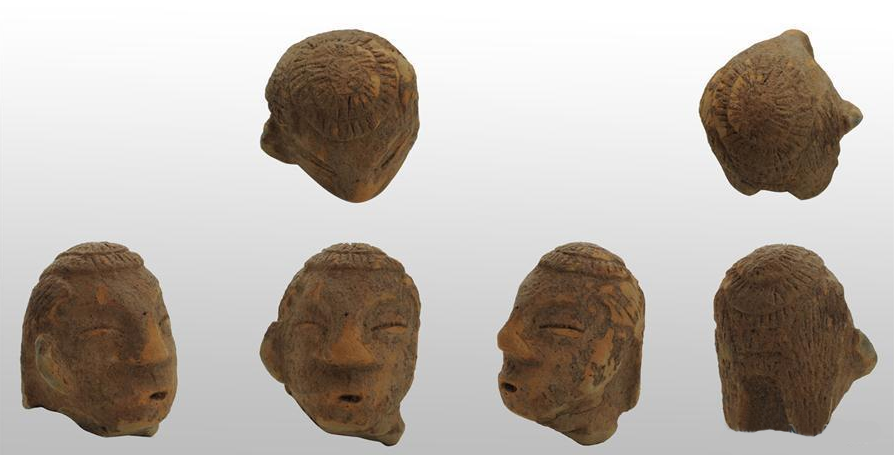Top discoveries of 2016: New breakthroughs in archaeology

The picture shows pottery head sculptures unearthed in the Banlashan cemetery of the Hongshan Culture in Chaoyang, Northeast China's Liaoning Province, one of the six selected archaeological discoveries for 2016.
The Chinese Academy of Social Sciences (CASS) announced the six selected archaeological findings of 2016 on Jan. 10 in Beijing.
The six discoveries are: the Niupodong cave site in Gui’an, Guizhou Province; the Banlashan cemetery of the Hongshan Culture in Chaoyang, Liaoning Province; the Neolithic Shijiahe site in Tianmen, Hubei Province; the Huangchengtai at the Shimao site in Shenmu, Shaanxi Province; the Bronze Age Jirentaigoukou site in Nileke, Xinjiang Uygur Autonomous Region, and the Xizhucun tomb of the Cao-Wei Period in Luoyang, Henan Province.
Through the excavation of the culturally rich Niupodong cave site, archaeologists established the first chronological framework extending from the late Paleolithic to early Neolithic period in central Guizhou. Tombs found in the site fill in the gaps of burials in prehistoric cave sites in the province and provide important clues for research on physical features of prehistoric humans. Moreover, excavations unearthed a microlith, a type of small stone tool, for the first time in Guizhou, offering references for investigations into the emergence and spread of microlith craft in Southwest China.
The dig at the Banlashan cemetery fully revealed the process of layered stone tomb construction in the later period of Hongshan Culture, a Neolithic culture in Northeast China dating from about 4700 to 2900 BCE. The layout of the cemetery, structure of burials and unearthed relics are of great significance to research on the burial customs of the Hongshan Culture as well as the origin of the Chinese civilization.
A new batch of jade objects discovered in the Neolithic Shijiahe site in Tianmen, the largest prehistoric settlement ever found in the middle reaches of the Yangtze River, enrich studies on the course of the Chinese civilization. Common techniques employed on the unearthed jade artifacts, like circular engraving, openwork carving and bas-relief, represent the highest level of jade processing in prehistoric China and even East Asia.
The Huangchentai remains are the highest part within the larger Shimao walled site. Bronze knives and arrowheads uncovered from the remains mark another important discovery of early Chinese bronze. Evidence of a bone workshop was discovered in the northeast. These discoveries are enlightening for the exploration of the settlement structure at the top of Huangchengtai and the structure of the social structure within the larger Shimao site.
The Bronze Age Jirentaigoukou site is the largest Bronze Age settlement in the Yili area of Xinjiang. Clay molds, clay air pipes, and slag and ash layers indicate that bronze making was one of the main activities in the site. Three pieces of iron blocks are among the earliest iron objects ever found in China and are illuminating for the research on the diffusion of iron-making techniques. More significantly, a large amount of coal and ash was found in some pits and houses. This is the earliest evidence of the use of coal in the world, predating previous discoveries by nearly 1,000 years.
Though the Xizhucun Tomb of the Cao-Wei Period was looted, there are still about 500 pieces of ceramic vessels and iron, bronze, lacquer, wooden and jade objects left. The funerary objects exhibit transitional features from the Eastern Han Dynasty to the Western Jin Dynasty. The discovery is inspirational to the research on the selection and formation of burial areas during the Cao-Wei Period.
At the meeting, a new section was dedicated to the featured discovery made by Chinese archaeologists overseas. For 2016, the honor went to the Mingtepa walled site in Uzbekistan.
The CASS archaeological team has conducted four excavations of the Mingtepa walled site in Uzbekistan together with archaeologists of the Uzbekistani Academy of Sciences from 2012 to 2015 based on cooperative agreements. The fifth dig in 2016 found the outer walled city of the site for the first time, extending archaeologists’ knowledge of the site’s spatial layout.
Meanwhile, through the excavation of handicraft workshops in the southern wall of the inner city, they made clear the architectural characteristics and cultural connotations of the workshops. The new discoveries made in spring 2016 show that the Mingtepa walled site is not only the largest site in Fergana Basin around the Christian era, but also the largest ancient walled site in Uzbekistan. The archaeological breakthrough has changed the way international archaeologists view the status of the site in Fergana Basin and the ancient Silk Road in Central Asia.
This article was translated from People’s Daily.
